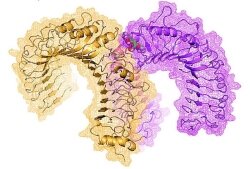Web Date: August 22, 2012
Small Molecules Target Toll-Like Receptors
News Channels: Analytical SCENE, Biological SCENE, JACS In C&EN
Keywords: Chemical biology, toll like receptors, autoimmune disease, oncology, molecular probe

Aided by high-throughput screening, chemists have found new ways to target Toll-like receptors (TLRs), membrane-spanning proteins that provoke inflammation and immune responses. The research, presented on Tuesday in the Division of Organic Chemistry at the American Chemical Society national meeting in Philadelphia, might speed development of new treatments for infectious diseases or cancer.
It’s proven tough to disrupt the complexes that TLRs form with proteins or genetic material, explained Hang (Hubert) Yin of the University of Colorado, Boulder. Yin’s team has developed screens to rectify that. One of their assays, conducted in macrophage cells that contain all types of TLRs, monitors production of nitric oxide, an indicator of receptor activity. In Philadelphia, Yin explained how optimizing hits from that assay and others led to inhibitors for complexes involving TLR3 and TLR4 (J. Am. Chem. Soc., DOI: 10.1021/ja111312h; Proc. Natl. Acad. Sci. USA, DOI: 10.1073/pnas.1200130109; ACS Med. Chem. Lett., DOI: 10.1021/ml100041f).
In not-yet-published work, his team has developed the first small-molecule probe for the complex between TLR1 and TLR2, implicated in autoimmune diseases and cancers. The probe, called CU-CPT22, is specific for TLR1/2 and might be useful for evaluating more druglike inhibitors, Yin said.
Yin “is clearly targeting an important series of challenges in medicine,” said Lisa McElwee-White of the University of Florida, who moderated the session at which Yin spoke. “His work is an excellent illustration of how small molecules can tackle biological problems.”
- Chemical & Engineering News
- ISSN 0009-2347
- Copyright © American Chemical Society
